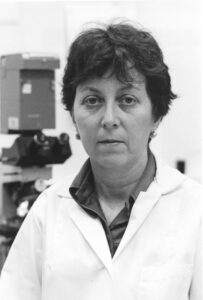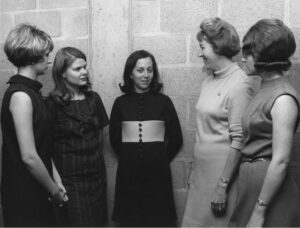On July 2, a magnificent light went dark.
The world of rheumatology lost Naomi Rothfield, MD, MACR, that day. Known for her brilliance, tenacity and patient advocacy, Dr. Rothfield, who spent nearly 50 years at the University of Connecticut School of Medicine [UConn], Farmington, has left lights burning all over the world as the multitude of rheumatologists she trained continue her legacy of excellence.
Standard Bearer
“I met Naomi in 1976 when I accepted a position at [UConn],” says longtime friend, Arthur Weinstein, MD, MACR, clinical professor of medicine at Loma Linda University, California, and clinical professor of medicine emeritus, Georgetown University, Washington, D.C. “I had been looking for a setting with a strong lupus research program, and Naomi’s focus on caring for and studying patients with lupus contributed to her already established reputation throughout New England and into New York. Lupus patients arrived from all over for either a one-time consultation or continuous care and referrals from other doctors were plentiful. In this way she built one of the largest lupus centers in the country at that time.”
After graduating from Bard College, Annandale-on-Hudson, New York, in 1950, Naomi Rothfield received her medical degree from New York University School of Medicine in 1955. Her internship was at Lenox Hill Hospital, New York, and her rheumatology fellowship was undertaken at New York University (NYU) School of Medicine. She held several teaching positions at NYU, where she eventually became assistant professor in 1964.
In 1968, Dr. Rothfield was a member of the first faculty of the University of Connecticut School of Medicine, initially serving as an associate professor in the Department of Medicine. She became a full professor in 1973; from that time until 1999, Dr. Rothfield was chief of the Division of Rheumatic Diseases. From 1978–98 she directed the National Institutes of Health (NIH)/University of Connecticut Multipurpose Arthritis Center.
“Naomi worked harder than all of us,” says Dr. Weinstein, “which was quite amazing since she was still very involved as a mother to her four children. Her intelligence, drive, inquisitiveness and focus were outstanding, and she parlayed that into obtaining continuous NIH funding to support her research and, often, that of her faculty. Also, she was very protective of her junior faculty’s time so that it was not subsumed by university committee affairs.”
“Her major guiding principles were to enhance the care of lupus patients by careful observation and documentation of this multifaceted condition and by greater understanding of the pathophysiology of lupus through excellent clinical and laboratory correlations and research studies.”
“Naomi’s extraordinary concern for her lupus patients translated into her giving her telephone number to many patients. They called her frequently to discuss not only their condition, but also personal life events.”
“As an educator, Naomi expected a high standard of knowledge from her trainees through reading, attending academic meetings, participating in clinical or laboratory research, and presenting and publishing results. She also expected a high standard of clinical and empathetic care for all patients and for lupus patients in particular. I recall that after our busiest lupus clinic, the fellows and faculty spent another 60–90 minutes reviewing and discussing each patient who had been seen.”
From France to Farmington
Fate paired Dr. Rothfield with a young immunologist named Maurizio Zanetti, MD, a professor of medicine at the University of San Diego, La Jolla, Calif., when they shared an office in Paris. “She was the chief of rheumatology at UConn and was doing a sabbatical in France. We became friends, and when she invited me to come to the U.S. she sounded like the prophet of my future. I accepted her offer, and actually stayed with her and her family for the first two months in the U.S.”
“Naomi’s leadership skills were legendary. She was always on top of any situation,” says Dr. Zanetti. “She dove into projects with a rarely seen vibrancy and enthusiasm. I think her passion is what she will most be remembered for. In running the division, she would skillfully connect the dots for patients in order to improve their lives. She saw their misery and was determined to do something about it using the best Medicine had to offer in those days. Naomi didn’t allow things to stand in her way. I can close my eyes and see her working feverishly on a grant, hacking away on an old typewriter.”
“Last month there was a celebration of life for her husband, and we got to sit together. She still ‘had it’ and recalled the names and situations of multiple patients from 43 years ago.”
Micha Abeles, MD, a rheumatologist at the Center for Arthritis and Rheumatologic Disease in Meriden, Conn., worked with Dr. Rothfield for 40 years. “She was a brilliant physician who was demanding, exacting and expected excellence from those who worked with her. I recall when she seemed to have written chapters on systemic lupus erythematosus (SLE) for every textbook available. I watched in amazement as she typed without notes because she knew the literature by heart.
“She had many firsts, such as being the first to understand the relationship of steroids to osteonecrosis, to point out the overall benefit of hydroxychloroquine in SLE when others doubted, etc. She was able to obtain a multipurpose arthritis center grant of which only five or sixwere awarded in the country.”
“Dr. Rothfield was internationally known. Whatever meeting I attended, whenever I spoke to someone who found out I was from the University of Connecticut, the first question they would ask was, ‘How is Dr. Rothfield?’”
Big Thinker
Santhanam Lakshminarayanan, MD, chief of the Division of Rheumatology at UConn School of Medicine, had his sights set on learning from the best many years ago. “Even back in my medical college days, Naomi was famous in India, where rheumatology had not yet become a subspecialty. Reading about lupus in my second year I knew I wanted to be rheumatologist. I sought her out and during my second year in residency I received a page from Dr. Rothfield, who said, ‘Laks, do you want to start your fellowship this July?’ I jumped at the chance, and she arranged everything. I skipped a year of residency. As my then program director in medicine said, ‘I can’t say no to Naomi.’”
“Naomi was an exceptional visionary,” he adds. “In the third year of my fellowship she reached out to a primary care practice that had an extra examination room. We would see patients there and then drive like the devil to get blood samples back to the lab at UConn, the whole process being geared toward making a permanent location so that UConn would bring me on as faculty—but that didn’t happen. However, 30 years later UConn purchased that very same practice.”
And if things weren’t 100% right for her patients, she let it be known.
Dr. Lakshminarayanan: “We had a lupus patient with chest pain come into the hospital. When Naomi heard the plan was to transfer her to Hartford Hospital because we didn’t have interventional cardiology—this was 1996—she was not happy. ‘What the hell kind of place are we running here? Is this a hospital or a hotel?’ And she was right. As an academic center, we should have been ahead of the curve.”
“On another occasion, it was 8 a.m. in clinic, and our patients were shivering. ‘This is ridiculous,’ Naomi said, and picked up the phone to express her displeasure. The repair people showed up, worked on the heating and left. Around 2 p.m. she picked up the phone again and said, ‘It’s too hot in here now.’ Back came the repair guys. At the end of clinic, I asked who she had called. ‘The dean,’ she replied.”
She Started a Fire
Naomi Rothfield started the Lupus Foundation and co-founded and ran the Connecticut chapter of the Scleroderma Foundation. “Where there was no kindling, Naomi started a fire,” says Dr. Lakshminarayanan. “For her ongoing dedication, she was honored with a Lifetime Achievement award by the Arthritis Foundation.
“Naomi taught me to speak my mind and if I was doing the right thing to forget about the consequences,” he says.
“To establish a division, start a training program, lead the division to international renown as the lupus center of the East and keep the focus on patient care and continually strive to improve their lives, that is a phenomenal legacy.
“Naomi did all of this at a time when women were not admitted to medical schools, and if they were admitted, then they were not accepted, often not acknowledged for their contributions, invariably struggled for advancement and rarely got accolades.
“Her enormous productivity, persistent pursuit of excellence, pioneering vision, relentless energy, and tireless championing of patient care, research and education were key in making the division nationally and internationally renowned. Her expertise has improved the quality of life of innumerable patients over the years and continues to impact positively on patients’ lives now. Quite apart from that, she, more than anyone else in the division, was instrumental in the education and training of a great number of rheumatologists who are currently in careers in both academic settings and private practice all across the country and across the world—Canada, Europe, Asia Australia. There is no price that can be put on a lifetime of such service.
“She taught us all by example. Her patients have always been front and center in anything she did in her professional life, an ethos she imbued in all of her trainees.
“Complete strangers have stopped me at international meetings after reading my name tag and seeing where I work to ask, ‘How is Naomi?’ That encapsulates her impact, reach, influence and reputation, and reveals the level of affection people have for her.
“Her fundamental message to me was that patient advocacy is what you do as a physician—always. It is not a punchline or a separate career.
“If I was wearing a hat, I would doff it,” concludes Dr. Lakshminarayanan. “We are eternally in your debt, Naomi.”
Elizabeth Hofheinz, MPH, MEd, is a freelance medical editor and writer based in the greater New Orleans area.





